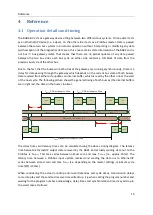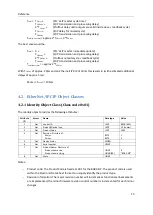
Reference
14
4
Reference
4.1
Operation details and timing
The BG02-EIP acts as a gateway device sitting between two different bus systems. On one side it acts
as an Ethernet/IP device (i.e. a slave), on the other side it acts as a Profibus master. Data is passed
between these two bus systems in an atomic operation without interpreting or modifying any data
(with exception of the diagnostics data area, this area contains state information of the BG02 and is
not bus
bus gateway data). That means that there are no partial updates of any data passed
between the two bus sides, each bus cycle on either side contains a full block of data from the
previous bus cycle of the other bus.
Due to the fact, that the busses on both sides of the gateway are running asynchronously, there is a
delay for data passing through the gateway which depends on the current bus state of both busses.
Data received from either side updates an internal buffer, which is read by the other one at the start
of the next cycle. The following picture shows the general timing of both busses (the internal buffers
are in light red, the data on the busses in olive):
out
in
out
in
in
out
out
in
in
out
T
PDPcyc
PDP cycle approx. 20ms
T
PDPcyc
PDP cycle approx. 20ms
T
EIPcyc
Ethernet/IP cycle approx. 50ms
Profibus
E/IP [n]
[n+1]
[n-1]
Ethernet/IP
Profibus [m]
[m-1]
[m+1]
T
lat(out)
T
lat(in)
The delay times and latency times can be calculated using the above timing diagram. The latency
time between Ethernet/IP output data received by the BG01 and actually sending data out to the
Profibus is T
lat(out)
. This time varies between almost zero and max. T
PDPcyc
(i.e. approx 20ms). The
latency time between a Profibus input update received and sending the data out to Ethernet/IP
varies between almost zero and max T
EIPcyc
(i.e. depending on the master settings, minimum cycle
time (RIP) is 20ms).
When considering the actual roundtrip end-to-end latencies and cycle times, transmission delays
come into play and the send and receive time will add up. E.g. when setting the program number and
waiting for the program number acknowledge, delay times and synchronization times may add up in
the worst case as follows:



































